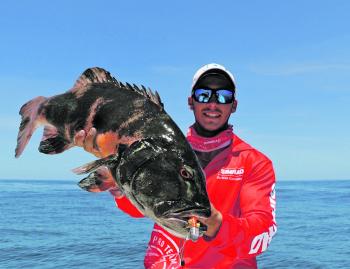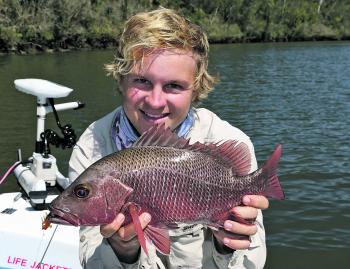Barra season is upon us, and YES Hervey Bay is home to the mighty barramundi – and quite a healthy population at that! With the average size of fish being around 80cm and the magic 1m+ fish being a semi-regular capture, the quality of Fraser Coast barra can sometimes rival better-known waterways found further north.
The Mary and Susan river systems have been the go-to areas, with anglers casting and retrieving lures to great effect, targeting rocky outcrops, rock bars and drains on the run-out tide. ZMan 4” SwimmerZ, Samaki Vibelicious soft vibes and Jackall Squirrel 79SP hardbodied lures have been doing the damage. Threadfin salmon have been in great numbers in close vicinity to the barra and are suckers for a soft vibe worked deep, or a shallow diving hardbody erratically worked out of a drain.
We have experienced one of the hottest and driest summers we have ever seen, and species like the mangrove jack have been responding well to the heat. The Burrum River system and its tributaries (Gregory, Cherwell and Isis) have been a poplar haunt, with anglers targeting rock bars and laydowns finding quality fish. Soft plastic prawn imitation lures and deep diving hardbodies have been the lures of choice, along with well-presented live baits. Remember to always carry a cast net at this time of year, as prawns have been running in the upper reaches of the system. Prawns not only make great live bait but also make for a tasty feed. Just a reminder, that there is a 10L per angler possession limit.
The grounds wide of the Burrum River have been producing queenfish, giant trevally, mac and longtail tuna and a variety of mackerel species which have been harassing the masses of bait that have started to congregate wide of the leads. The best results have come from later in the day. This is when the surface temperature of the water is warmest, and the predatory fish have had time to herd the bait into balls before annihilating them. Watching packs of queenfish cruising the surface and circling the boat has been quite a spectacle. Fast-paced lures have been drawing the greatest attention, with Cotton Cordell Pencil Poppers and ZMan 5” StreakZ being the standouts.
This is the time of year when our wider reefs, like the ever popular Southern and Northern gutters systems, start to fire. Here you can catch the renowned XOS coral trout and an assortment of other mixed reef species for the table. Having good quality electronics is a must in these areas, as locating the ledges and isolated bommies is crucial to success. Smaller, isolated patches produce the better quality fish. Well-presented live baits in the form of yakka or pike, fresh cut baits and an assortment of soft plastics have produced great results.
The main areas of reef which see the constant flow of traffic continue to be plagued by the men in grey suits. It makes it almost impossible to boat a fish, and sticking around in these areas is only devastating the reef system. You will never beat the sharks so it pays to move as soon as they become a nuisance.
For the die-hard pelagic anglers, this is the time of year to be picking your days in the weather and venturing further afield, wide of the Break Sea Spit with larger poppers and stickbaits in search of GTs and Spanish mackerel. If a big black broaching GT or a high flying Spanish doesn’t get your heart and adrenalin pumping, nothing else will! It is important to fish the moon phases. The full and new moon periods produce the best results, with the bigger tides creating more profound pressure edges and back eddies.
Platypus Bay has come to life with the famous Hervey Bay longtail population finally showing up to the party, terrorising the masses of baitfish. Wind direction plays a large part in dictating where to go in search of them, as it shifts the bait and in turn the tuna follow. In the bay a northerly blow will push the bait out wide of Roonies and in turn the pelagics, so we can only hope to get some consistent south to southeasterly winds to draw the bait in closer to the Wathumba area. Sharks are an ever-growing problem, with tuna being a staple of their diet.
The warmer water temperatures have continued to see our inshore reefs producing quality coral trout, blueys, cod and sweetlip (also called coral bream). Trolling hardbodies and hopping soft plastics along the reef flats and edges have been successful for the trout and cod. The blueys and sweetlip have been taking fresh firm baits like crab, prawn, hardiheads and local pencil squid. All you need to get some pencil squid from the inshore reefs is a few 1.5-2.0 sized squid jigs.
So, all in all, it has been a great month with the fishing certainly starting to improve. Both the inshore and offshore reefs are firing and the pelagic action is really about to heat up.
Reads: 2589
A coral trout caught by the author from the northern gutters, fooled by a well-presented soft plastic.

Guy Scotney with a 45cm jack which took a liking to a slow presented Zerek Live Prawn fished over a rock bar.




